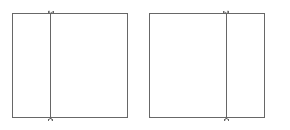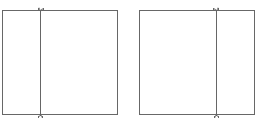 CUSHION COURSE
YOUR MAKES
YOUR REVIEWS
CALCULATORS
ABOUT US
CONTACT US
MATERIALS
TOOLS
PRICES
PRO SUBSCRIPTION
LOG IN
CUSHION COURSE
YOUR MAKES
YOUR REVIEWS
CALCULATORS
ABOUT US
CONTACT US
MATERIALS
TOOLS
PRICES
PRO SUBSCRIPTION
LOG IN

The BASIC STEPS when PREPARING YOUR FABRIC are.
PLAIN and PATTERNED FABRIC are treated differently at this stage Select your fabric type.
CHECK YOUR FABRIC
Check your fabric for faults and that the correct length has been supplied NOW before making any cuts, marks or pressing. Also if using a patterned fabric, measure and check the quoted pattern repeat is correct and mark out your adjusted cut drops with pins as detailed in "Patterned Fabric" below.
CUT PLAIN FABRIC DROPS
Plain fabric drops are cut in the same way as the lining.
SPLIT HALF WIDTHS
If you are making a pair of curtains using an odd number of widths, you will have half widths on the outside of each curtain.
Cut down the centre of one of the widths to split it into 2 equal halves.
PRESS YOUR CUT DROPS
In the workroom after cutting the drops we press them if the fabric is suitable.
Press your fabric* cut drops so any shrinkage will be before the curtain is made up. As once the curtain is made it may be slightly creased and if you have not already ironed the panels they may shrink if you press/steam them later having not done this first.
*IRONING YOUR FABRIC:
YOUR FABRIC MAY NOT BE SUITABLE FOR PRESSING OR STEAMING - ALWAYS read the manufacturer's care instructions for the fabric and test iron a spare piece before ironing. Use caution with steam and make sure the iron has been descaled and cleaned out to avoid staining from limescale.
ALWAYS TEST YOUR IRON ON A SPARE PIECE OF FABRIC FIRST!!!
JOINING PLAIN FABRIC
If each curtain is more than one width wide, we now need to join the required widths to make each curtain fabric panel.

PRESS OPEN THE SEAMS
After joining, press open the seams.
PATTERNED FABRIC
This tutorial is based on a Standard pattern repeat fabric, to see if your fabric has a half drop pattern repeat please read HERE and adjust the instructions accordingly.
CHECKING PATTERNED FABRIC
When checking a patterned fabric for faults and length we also measure the vertical pattern repeat to check it is as stated by the supplier. Often it is slightly different (less than a cm) which will change the adjusted cut drop ACD value but not usually enough to cause problems. Sometimes though they get it completely wrong making the ACD very different and the hence you may not have enough fabric. (CHECK BEFORE YOU MARK, PRESS OR CUT). More Details
MARK THE ADJUSTED CUT DROPS WHEN CHECKING
It is very easy to make a costly mistake cutting your drops wrong with patterned fabric. That is why we recommend the following method marking out everything before cutting. This also gives you the opportunity to check the fabric for faults and that you have enough length.
We mark adjusted drops ACD, these were calculated in STEP 3 (or re-calculated after measuring the Pattern Repeat) and are a whole number of vertical pattern repeats, so we are always cutting the drop in the same place on the pattern. That way the cut drops are identical and the pattern lines up when we come to join them.
In this example fabric the pattern is such that there is no obvious pattern placement needed so we elected not to add a pattern repeat to place the fabric. The starting point for the first Adjusted Cut Drop will be at the bottom of the fabric.
To mark out the Adjusted Cut Drops.
IF YOU ARE PLACING THE PATTERN (WITH AN EXTRA PATTERN REPEAT)
With a patterned fabric you may have included an extra pattern repeat to place the pattern on the curtain.
When placing the pattern we decide where the pattern will finish on the bottom of the curtain. (we choose the position at the bottom of the curtain because this is what your eye picks up). We then measure down from there the hem allowance and this will be the point you will start measuring your drops from. Note this starting point must be within the first "Extra" Pattern Repeat you ordered.
The first ACD will be longer than the other cut drops as it will include the excess fabric from the extra pattern repeat to position the pattern in the correct place, at the bottom.
CUT THE MARKED DROPS (PATTERNED FABRIC)
Now you have checked the fabric has no faults and there is sufficient for your project, you can cut the drops.
If the curtain fabric panels contain more than one width each we now need to join the widths to make the curtain fabric panels
SPLIT HALF WIDTHS
If you are making a pair of curtains using an odd number of widths, you will have half widths on the outside of each curtain.
Cut down the centre of one of the widths to split it into 2 equal halves.
PRESS YOUR CUT DROPS
In the workroom after cutting the drops we press them if the fabric is suitable.
Press your fabric* cut drops so any shrinkage will be before the curtain is made up. As once the curtain is made it may be slightly creased and if you have not already ironed the panels they may shrink if you press/steam them later having not done this first.
*IRONING YOUR FABRIC:
YOUR FABRIC MAY NOT BE SUITABLE FOR PRESSING OR STEAMING - ALWAYS read the manufacturer's care instructions for the fabric and test iron a spare piece before ironing. Use caution with steam and make sure the iron has been descaled and cleaned out to avoid staining from limescale.
ALWAYS TEST YOUR IRON ON A SPARE PIECE OF FABRIC FIRST!!!
JOIN PATTERNED FABRIC WIDTHS
Your fabric panels* should begin and end in the same place on the pattern if you have cut them accurately according to the true pattern repeat. This will make joining them a lot easier.
*The first panel will probably be longer if you have positioned the pattern but will be cut at the top at the same point on the pattern as the other panels (the excess will be at the bottom and can be trimmed away after joining).

PLAIN and PATTERNED FABRIC are now treated the same.